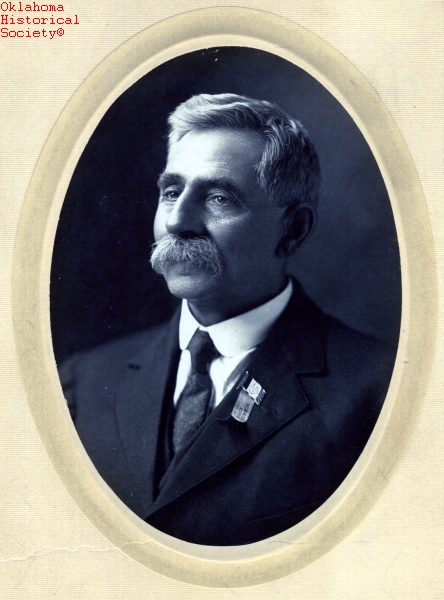The Encyclopedia of Oklahoma History and Culture
SEGER, JOHN HOMER (1846–1928).
Born to Andrew and Louisa Knox Seger in Geauga County, Ohio, on February 23, 1846, John Homer Seger was raised in Illinois. Enlisting in the Union army in 1864, he participated in Gen. William T. Sherman's "March to the Sea" through Georgia. Afterward, he worked in Wisconsin and by 1872 was living in New Malden, Kansas. In Indian Territory a reservation had just been established for the Cheyenne and Arapaho people under the terms of the 1867 Treaty of Medicine Lodge. Seger was hired in 1872 as a mason-carpenter by John D. Miles, the U.S. Indian agent at the new agency headquarters at Darlington on the Cheyenne-Arapaho Reservation. Seger's assignment would be to build houses and buildings at the agency school.
As he worked at the agency, Seger developed a rapport with the Cheyenne and Arapaho people. In 1875 Miles asked him to serve as superintendent of the Arapaho Manual Labor and Boarding School, which had opened in 1872. It was federally funded, but missionaries of the Society of Friends (Quakers) operated it under the "Quaker Peace Policy" of Ulysses S. Grant's presidential administration. When the Cheyenne students were separated into the Cheyenne Manual Labor and Boarding School in 1879, he supervised that also. As the Indian Service began its policy of forced assimilation through manual arts training and religious education (the "Pratt system"), the curriculum expanded to include craft training and especially farming and herding for the male students. Seger was very successful in helping the students build up a herd of cattle to supplement meager institutional income. He remained with the schools until May 1882 and thereafter apparently made a living building fences for cattle companies that leased grazing land on the reservation, by running a mail route from Darlington to Mobeetie, Texas, and by running a sawmill and a small horse ranch near Cobb Creek, about fifty miles southwest of Darlington.
By 1885 the Cheyenne and Arapaho faced the land allotment process that was then being proposed in Congress. Indian agent Jesse Lee asked Seger to establish one of four "colonies" that would concentrate Indian families in agricultural communities many miles distant from Darlington. In 1886 he convinced 120 people, many his former students, to move to good farmland on Cobb Creek. "Seger Colony" as it came to be called, was a dispersed rural district of about a thousand square miles. The Mennonites opened a mission in 1889. In 1896 the Dutch Reformed Church established a mission operated by Frank Hall Wright, Walter Roe, and others.
John Seger built the federally funded Seger Industrial Training School (at present Colony) in 1893 and for twelve years served as superintendent. In 1890–91 he became a special agent appointed to help allot the reservation lands to individual tribe members. He was an annual participant in the Lake Mohonk Indian Conference in New York. After he retired in 1905, Seger continued to live in Colony, dying there on February 6, 1928. Seger Indian Training School, which operated through 1932 as a boarding school and into the 1940s as a day school, is listed in the National Register of Historic Places (NR 71001080).
See Also
Bibliography
Donald Berthrong, The Cheyenne and Arapaho Ordeal: Reservation and Agency Life in the Indian Territory, 1875–1907 (Norman: University of Oklahoma Press, 1976).
Henrietta Mann, Cheyenne-Arapaho Education, 1871–1982 (Boulder: University of Colorado Press, 1997).
John H. Seger, Early Days Among the Cheyenne and Arapaho Indians (Norman: University of Oklahoma Press, 1934).
William D. Welge, "Colonial Experience on Cobb Creek: A Modest Attempt of Indian Acculturation" (M.A. thesis, Central State University, 1988).
Citation
The following (as per The Chicago Manual of Style, 17th edition) is the preferred citation for articles:
Dianna Everett, “Seger, John Homer,” The Encyclopedia of Oklahoma History and Culture, https://www.okhistory.org/publications/enc/entry?entry=SE005.
Published January 15, 2010
© Oklahoma Historical Society


